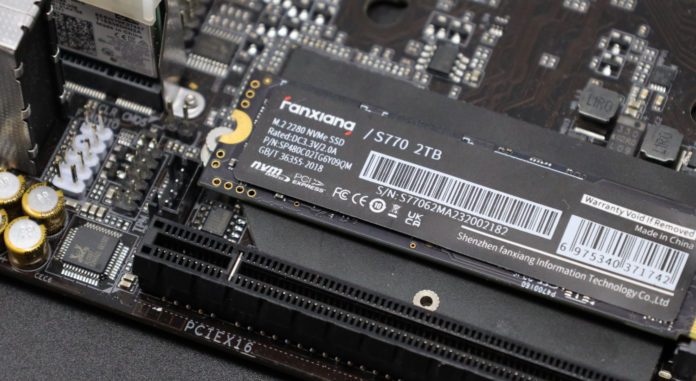Today we are looking at the Fanxiang S770 2TB SSD. Who is Fanxiang? I certainly had never heard of them, until Patrick ran into a couple of their SSDs as part of his fanless firewall appliance series. When we originally started seeing these drives in the STH Mini PC series, we could not find them actually thinking the company name was “ranxiana” given the strange brand logo. The full company name is SHENZHEN FANXIANG INFORMATION TECHNOLOGY CO, LTD, and as you might gather from the name this product is made in China. We are looking at this drive because it is compellingly priced, and because it has shown up out there in the wild and on Amazon. Not everyone will purchase a premium brand drive and there is not that much information on these, so we figured, why not?
Fanxiang S770 2TB NVMe SSD

The S770 packaging actually includes a heatsink that users can install for themselves, along with all the thermal pads, a tiny screwdriver, and M.2 screw. Fanxiang is definitely getting points here for the pack-ins.
As for the drive itself, the Fanxiang S770 2TB comes in a double-sided M.2 2280 (80mm) form factor.

The S770 sports an Innogrit IG5236 controller, which we have seen before on drives like the HP FX900 Pro. Paired with that is a DRAM cache and YMTC 128-layer NAND.

As a double-sided drive, the back of the Fanxiang S770 is home to half the NAND and half the DRAM. Curiously, on the S770 the back is also where the Fanxiang label and logo are located. This has no effect on drive performance, but the labels usually go on the front of the drive so you can see the brand while the drive is installed.
Fanxiang S770 SSD Specs
The spec sheet says the Fanxiang S770 comes in 1TB, 2TB, and 4TB capacities.

I can only find the 1TB and 2TB capacities, but no matter. Normally in my reviews, this is the part where I post a spec sheet for this line of drives, which I tend to pull from the manufacturer’s website or data sheet on the drive. Instead, you get a screenshot from the Amazon listing. Why? Because while Fanxiang does have a website, their current model drives are not listed on that site. Not even the back of the box has much information. So this listing is really all I have to work with.
If the Amazon listing is to be believed, we should have a fairly high-performance drive on our hands. 7300 MB/s read and 6800 MB/s write is fairly top-tier among Gen4 SSDs. 1400 TBW endurance is certainly respectable, and a 5-year warranty is the industry standard. Of course, I have my doubts about the warranty if I cannot even find a spec sheet for the drive, so I will take the warranty duration with a grain of salt.

CrystalDiskInfo can give us some basic information about the SSD and confirms we are operating at PCIe 4.0 x4 speeds using NVMe 1.4.
Test System Configuration
We are using the following configuration for this test:
- Motherboard: MSI MAG X670E Tomahawk
- CPU: AMD Ryzen 9 7900X (12C/24T)
- RAM: 2x 16GB DDR5-6000 UDIMMs
Our testing uses the Fanxiang S770 2TB as the boot drive for the system, installed in the M.2_1 slot on the motherboard. This slot supports up to PCIe Gen 5 x4. The drive is filled to 85% capacity with data, and then some is deleted, leaving around 60% used space on the volume.
Next, we are going to get into our performance testing.





one comment:
please, put the raw values to 10hex in crystaldiskinfo. more human readable then 16 hex, which is jumbo-mumbo….make 10 hex as your default in cryataldiskinfo…
further, thanks for your effort…
@erik,
None of the values you are looking at will be particularly interesting regardless of display format, since it’s always a picture of essentially a brand new drive.
I think verifying the thermals reported by the drive with independent measurements would be useful for all SSDs. The thermals being more than reported could account for some of the inconsistencies during the testing.
Along similar lines, it would be interesting how well tools such as Linux smartctl work with each SSD and what information is actually reported.
RE temps – Jon Tanguy (Micron/Crucial) is quoted in “theregister”
” NAND, Tanguy explains, is happiest within a relatively narrow temperature band. “NAND flash actually likes to be ‘hot’ in that 60° to 70° [Celsius] range in order to program a cell because when it’s that hot, those electrons can move a little bit easier,” he explained.”
So has Fanxiang deliberately made the drive report incorrect temps ? And can they fix that remotely with a firmware update ? I have this exact drive on order from Amazon. Thanks Will for your reviews, they are very informative. Merry Christmas ⛄
I’ve bought some chinese SATA SSDs in the past that had harcoded temperatures.
I had an extremely useful comment and review and your anti-spam deleted it before it was even posted, before even sending anything, hadn’t even chose: name or email etc.. and it just detected something and erased the whole thing- congrats, you played yourself – what a great review system
2TB 90$?
Are you sure?
Can’t find in yours links that price…
Are you deleting any comments?
My comment was deleted!
my comment also not go thru